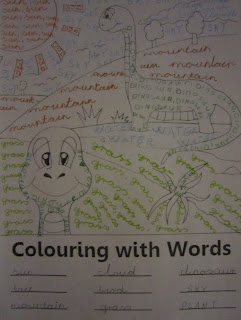This lesson was inspired by a post I saw on the Lines, Dots and Doodles blog. As soon as I saw it, I knew it would be a great drawing activity for ESL students.
Basically, instead of just colouring in a picture as normal, this activity requires the kids to write words (in English) to colour in their pictures. Even better, they usually have to write the words over and over again which is great spelling practice.
While it would certainly be possible to get students to create their own drawing from scratch, I decided to give them a customised colouring page to work with instead. I thought this was a safer option for ESL students because it enabled me to control the content of their pictures - the colouring page format ensured that the kids didn't draw pictures that were too complicated or that contained a lot of vocabulary that they weren't familiar with.
I did this activity with my Grade 2 class and all of the kids managed to finish colouring at least one picture during the 40 minute lesson. Here are a couple of examples.
The complete lesson plan is available by clicking "Read more".






